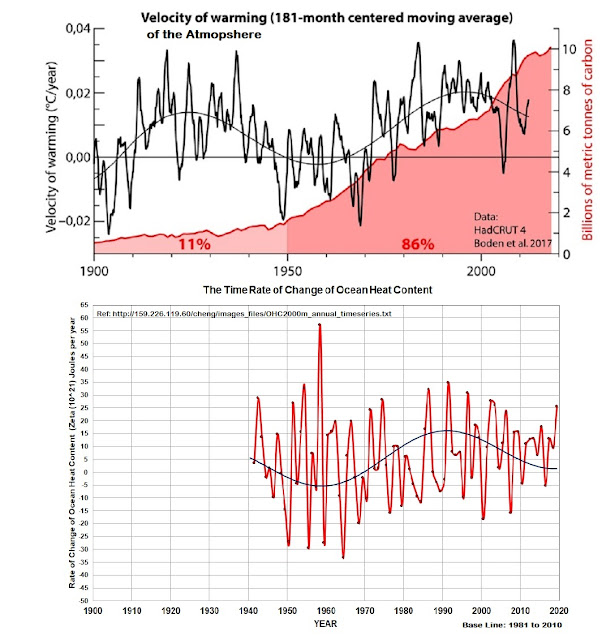HERE IS WHY THEY ARE WRONG!!
A. Annual to Bi-annual Temperature Increases and Decreases in Global Temperature
Figure 1 shows the University of Alabama - Hunstville (UAH) satellite-based lower troposphere temperature anomalies for the Tropics (+/- 20 deg. longitude) between December 1978 and January 2020.
What this graph shows is that the mean temperature anomalies for the lower troposphere of the Earth's Tropics exhibit a linear warming trend of +0.13 deg. C per decade (red dashed line), with sharp increases and decreases in temperature of approximately +/- 0.5 deg. C about the long-term trend, lasting for one to two years.
Figure 1.
It is well known that the annual to bi-annual excursions in temperature, above the long-term trend, are associated with El Nino and those below the long-term trend with La Nina events. The proof of this assertion is provided in Figure 2. This figure is a reproduction of figure 1 with a superimposed red curve showing the Bivariate EnSo Time Series (BEST) Index between 1979 and 2019. The BEST index has a value of +1 during El Nino months and -1 during La Nina months.
With one notable exception i.e. the 1991-92 El Nino event, all of the other identified El Nino events are followed by noticeable warming in the UAH temperature anomalies. Similarly, all of the identified La Nina events are associated with noticeable cooling in the UAH temperature anomalies.
[N.B. It generally accepted that the warming following the 1991-92 El Nino event was masked by a significant cooling event that was caused by the 1991 Pinatubo volcanic eruption.]
Ref: https://www.esrl.noaa.gov/psd/people/cathy.smith/best/
Figure 2.
This means that El Nino and La Nina events can explain almost all of the short-term (i.e. annual to bi-annual) increases and decreases in global temperature about the observed longer-term linear trend of +0.13 deg. C per decade. In addition, the rare exception to this rule can be explained by cooling events that are associated with large volcanic eruptions in the Tropics.
B. The Long-Term (Decadal to Inter-Decadal) Linear Increase in Global Temperature
Hence, we are left with a gradual linear increase in Earth's tropical temperature of approximately +0.13 deg. C per decade over the 40-years of the UAH (satellite) temperature record.
If we extend the global temperature record to the whole globe, rather than just the tropics, we find that between 1979 and 2012, the linear warming trend for the combined land and sea temperatures has been +0.155 ± 0.033 deg. C per decade according to the AR5 IPCC report (Ref: AR5 IPCC WG1 Chapter 2 p. 93)
Most climate scientists attribute much of this gradual increase in global temperature to human-induced climate change. However, the scientist's claims must be examined in light of other available temperature records that extend over a greater period of time. One such atmospheric temperature record is the HadCRUT4 produced by the Climate Research Unit (University of East Anglia) in conjunction with the Hadley Data Centre (UK Met Office).
The black curve in figure 3 shows the time-rate-of-change of the world mean HadCRUT4 temperature (i.e. (dT/dt) - also known as the velocity of warming - measured in deg. C per year). Superimposed upon the black curve, is a purple horizontal line showing the average warming rate between 1979 and 2012 of +0.16 deg. C per decade, claimed by the IPCC (AR5).
What is immediately clear from this graph is the linear warming rate of +0.16 deg. C per decade is only a crude approximation of what actually happened in the real world between 1979 and 2019. The longer global temperature record shows that the actual warming rate for the world's mean temperature varied up and down in a sinusoidal manner between a minimum of roughly -0.02 and a maximum of +0.20 deg. C per decade. It only averaged ≈
Contrary to the observed temperature data, the climate models indicate that the CO2 forcing of the atmosphere should be producing a steady increase in the rate of warming of the Earth's atmosphere with time [i.e. a straight line with a positive slope in figure 3]. This is particularly true after the end of WWII when CO2 levels begin to significantly increase because of human emissions. However, what is observed is at complete odds with the prediction of the models.
Hence, this post conclusively shows that anthropogenic CO2 cannot be the primary forcing term for the recent observed increases in the world's mean atmospheric and oceanic temperatures.
Figure 3
For supportive arguments, please read my earlier post entitled:
GAME OVER! This Madness has to end!
https://astroclimateconnection.blogspot.com/2020/01/game-over-this-madness-has-to-end.html
















